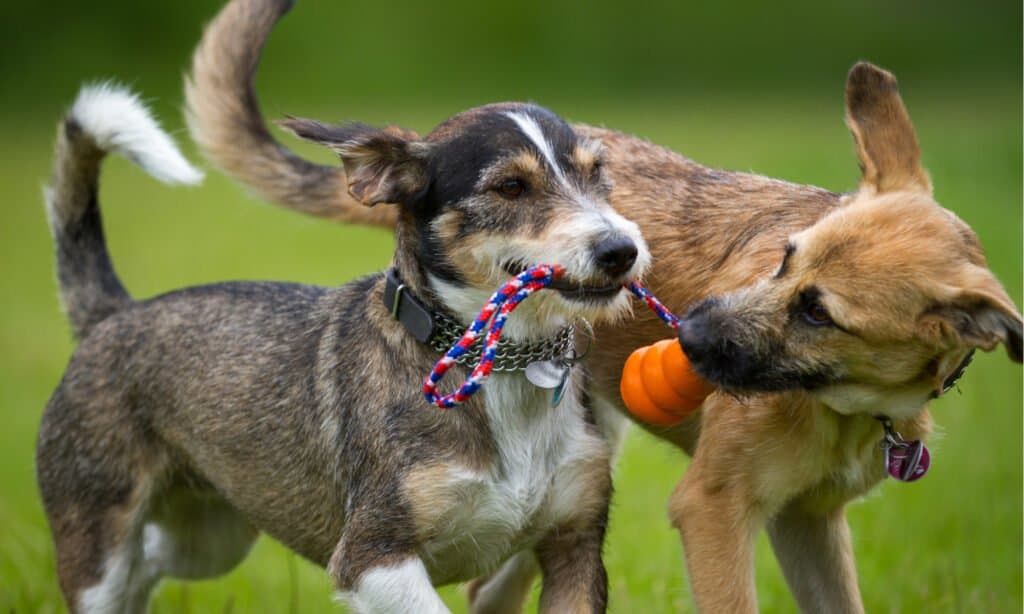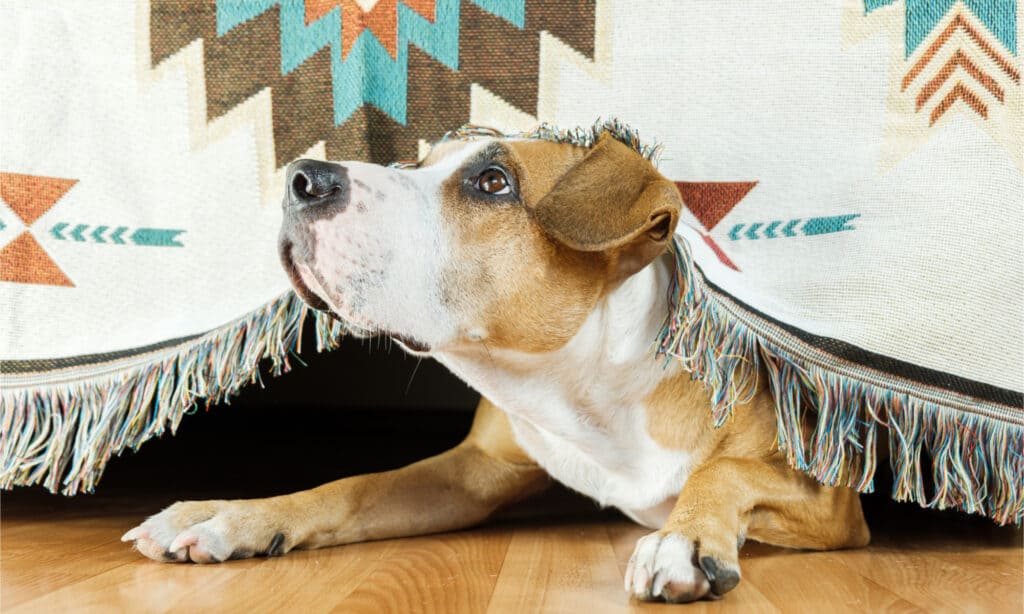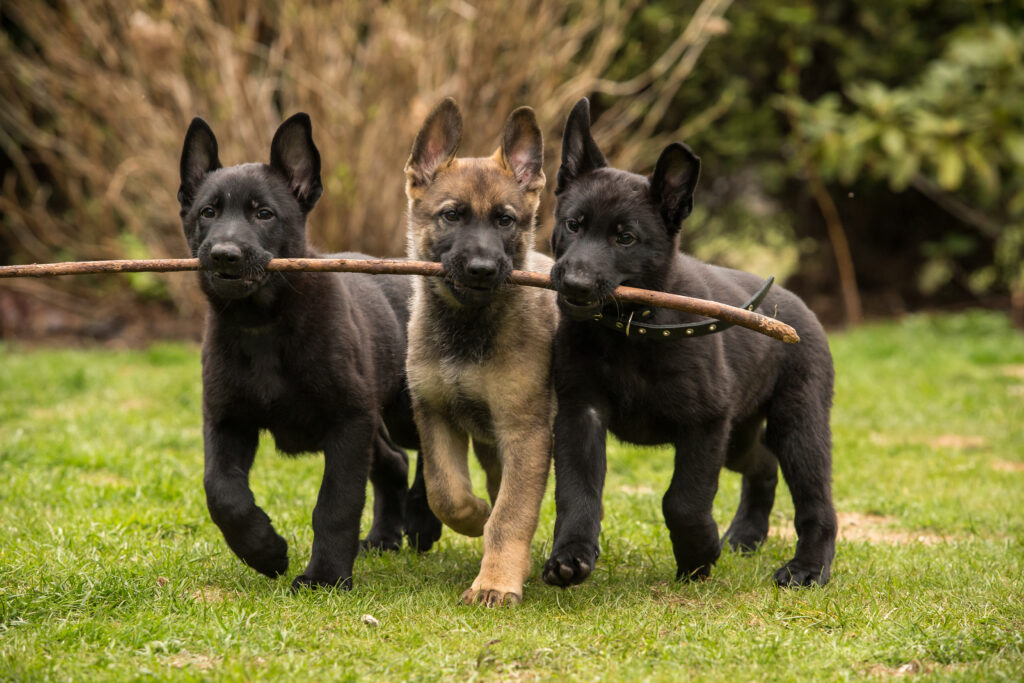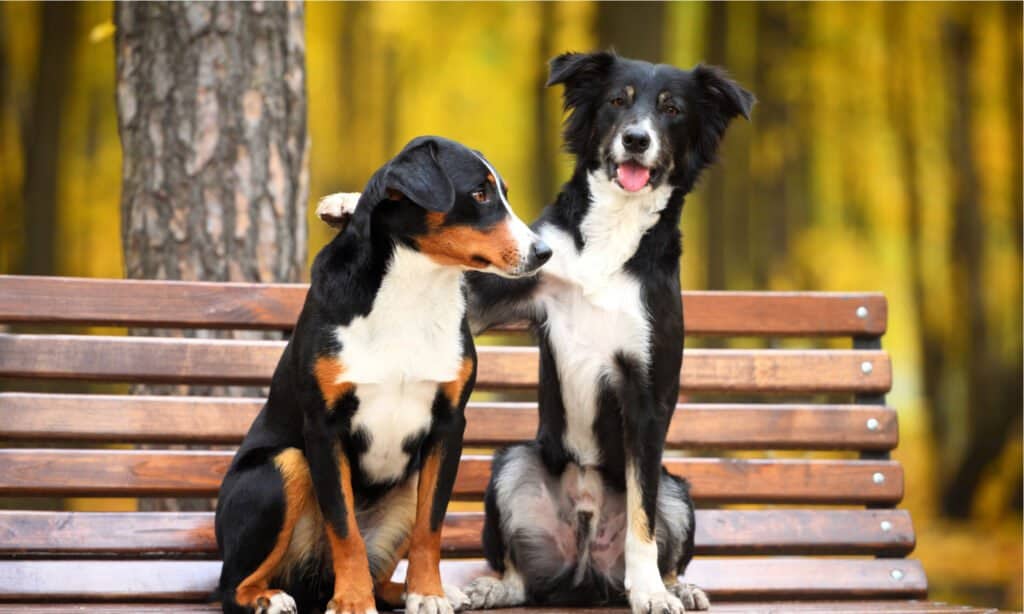Most of us with multiple dogs have two or more because we wanted our pups to have friends! It can be disappointing, frustrating, and even scary if they fight each other instead.
If your dogs are fighting, the first step is to separate them. Keep them separated until you have a plan to manage their fights, which may include avoiding triggers, ruling out illness, hiring a professional, or reintroducing your dogs.

This article will discuss whether dog fights are normal and 13 ways to stop dogs in the same household from fighting.
Is It Normal For Dogs To Fight Sometimes?

Play fighting is entirely normal, and two dogs living together will likely do it all of the time!
©Marek Rybar/Shutterstock.com
First of all, is it normal for dogs to fight? Well, this depends on how you define fighting.
When people talk about their dogs fighting, there are three things they may refer to:
- Play fighting
- Disagreements or arguments between dogs
- Violent fights
Play Fighting
Play fighting is entirely normal, and two dogs living together will likely do it all of the time! You might see them really roughhouse; body slam one another, bite each other, and more.
These “fights” can look violent; those who know nothing about dogs might think they’re hurting each other.
But dogs control themselves well and won’t draw blood or bite too hard while playing. (The exception might be dogs who weren’t well-socialized as puppies, especially those who were separated from their litter too young and haven’t learned bite inhibition.)
Disagreements Or Bickering
Also normal is your dogs having disagreements. This happens more frequently with very different dogs, whether in personality or age.
Of course, though, all dogs will have disagreements–just as you most likely bicker with other people in your human family.
Examples include your dog snarling at the other when they come close and the other backing off, barking when the other has a toy they want or giving warning bites when the other is getting too pushy.
Dogs don’t hurt each other in these kinds of disagreements or fights. Even if they nip or bite, they aren’t breaking the skin, grabbing each other and turning into little tornadoes of fur, or causing any kind of severe injury.
If your dog bickers often, it is a sign that you need to step in and establish some boundaries. It shouldn’t be up to one dog to constantly correct the other; you should be stepping in most times before it gets to that point.
However, the occasional disagreement with one another is normal. The true issue occurs when these boundaries are surpassed, and one dog just isn’t listening.
Violent Fights
Lastly, we have violent fights where your dogs truly show aggression toward one another. In these fights, they might draw blood or otherwise cause lasting injuries.
Know that most dogs have great control over how hard they bite. They’ll often start with nips that don’t break the skin and might progress into harder bites until they’re causing deep puncture wounds.
Violent fighting between dogs is not normal, and if your dogs are fighting this way, they must be separated immediately.
How Do You Stop Two Family Dogs From Fighting?
1. Separate The Dogs
As we discussed above, the first step is always to separate your dogs. You cannot allow them to continue fighting if they hurt one another, as these fights will likely become more severe. It can progress to the point where one dog kills the other.
The best way to separate two dogs in the same household is the “crate and rotate” method. This means keeping one dog in a space like a crate or room while the other accesses the rest of the house. Split it up equally, so both dogs have the same time to free roam.
Another option is to split the house 50/50 (or as evenly as possible) so that each dog has their own separate area of the house and cannot get into one another’s space.
I don’t recommend keeping one dog inside and the other outside, as this is unfair to the dog kept outside and often creates unsafe and neglectful living conditions.
2. Rule Out Illness Or Pain

Violent fighting between
dogs is not normal, and if your dogs are fighting this way
, they must be separated immediately.
©alexei_tm/Shutterstock.com
Next, it’s time to see a veterinarian. Do not skip this step!
Especially if your dog is suddenly showing aggression, it’s important to see if an underlying health concern is causing it. This might be an illness making them irritable or an injury that hurts when touched.
Sometimes, dogs will even show sudden aggression or other changes in attitude toward another dog with a health condition.
Before doing any kind of behavioral work, you must get both dogs a clean bill of health.
3. Hire A Force-Free Trainer Or Veterinary Behaviorist

Only consider hiring trainers experienced in
dog aggression
who refuse to use aversive methods or tools.
©Maria Sbytova/Shutterstock.com
Next up, decide if you need help managing your dogs’ behavior. If the bites are severe enough to break the skin, you shouldn’t attempt to fix the problem alone. It’s to the point where professional help is vital so that the fights don’t worsen.
Only consider hiring trainers experienced in dog aggression who refuse to use aversive methods or tools. Many trainers who call themselves “balanced” will jump to aversives without trying other methods, and all of them will hurt your dog to get the desired results.
Because the market is unregulated and aggression is a serious problem, many people opt to hire a certified veterinary behaviorist over a trainer. Ensure they have this exact title–anyone can call themselves a “dog behaviorist” or similar, even if they’re not certified and have little experience.
4. Create A Management Plan
The next step is to create a management plan, whether with your trainer or behaviorist or on your own.
Management is essentially changing your dogs’ environment to stop fights before they can occur. This might mean things like:
- Stepping in and separating the dogs when one shows signs of stress or annoyance
- Preventing resource guarding by offering toys only when the dogs are apart
- Feeding your dogs in separate rooms to prevent fights over food
- Keeping your dogs separated during high-stress times, like when visitors are over or when meals are being prepped, and both want to beg in the kitchen
You want to avoid things that trigger your dogs’ stress whenever possible. Your dogs should be kept separate for their safety when it’s impossible.
5. Provide Ample Resources

To avoid fights, It’s important that your dogs have enough of everything they need.
©Bildagentur Zoonar GmbH/Shutterstock.com
A top reason animals fight is that they feel insecure regarding resources. It’s important that your dogs have enough of everything they need.
This includes food, water, toys, spaces to relax comfortably, attention from you, and exercise.
Keeping these resources far apart can make them feel distinct to your dogs and also prevent one dog from hoarding everything.
For instance, keep water bowls in different rooms so that one dog cannot keep the other from drinking. Give each dog equal amounts of attention, so one doesn’t feel the need to bicker or fight with the other while you’re petting them.
6. Desensitization And Counterconditioning
Desensitization is exposing a dog to something they’re afraid of in amounts that it can handle while staying under its fear threshold. Counterconditioning is retraining a dog to have positive associations with said thing.
In this case, it’s a way to reintroduce two dogs with a poor relationship so that they can be confident and fear-free around one another.
Your dogs should be kept separate unless you’re actively working with them. During training sessions, you’ll keep them at a distance where both dogs feel safe observing each other. You might have to go outside on a leash and keep them very far apart.
They should be able to behave normally while engaging and disengaging with your other dog. At first, that’ll mean looking over at your other dog playing fetch, for instance, and then looking back at you and getting a treat.
Rewarding them for being around your other dog teaches them to have positive associations rather than the negative ones that come from fighting.
Slowly, you’ll bring your dogs closer until they can be side by side and eventually interact normally. This process can take weeks, months, or even longer and shouldn’t be rushed. It’s essential to go at your dogs’ pace, not your own.
7. Learn To Introduce Dogs Properly
Tossing two dogs into the same household and expecting it to go well will almost always come with some hurdles. Sometimes, it can completely and irreparably damage their relationship.
Instead, dogs should be introduced slowly and preferably in neutral territory. Introductions should be made on leash so that the dogs are within your control, and they should be allowed off-leash only once you’re sure they’ll get along.
It’s even better to introduce your dogs to each others’ scent before even allowing them to see one another. The next step would be letting them observe from a distance, then slowly bringing them together until they can finally interact.
Reintroductions can also be made in this way, though they’ll likely have to go much more slowly because the dogs already don’t trust one another. Repairing that trust will be more difficult than it would be for them to gain trust in one another when just meeting.
8. Learn Dog Body Language

Whining can be a sign that your dog
is anxious or afraid.
©Aleksey Boyko/Shutterstock.com
Do you know what whale eyes are? Did you know that dogs can wag their tails even when highly stressed or that licking their lips is a sign of discomfort?
It’s vital to learn dog body language before adopting one dog, let alone two or more who will interact with one another!
Only through knowing their body language can you see if there is tension between your dogs or if one is unhappy with another.
This will help you separate them before a fight occurs and can also help you enforce your dogs’ boundaries so fewer fights happen.
9. Enforce Your Dogs’ Boundaries

It’s vital to learn dog body language before adopting one dog, let alone two or more who will interact with one another!
©DTeibe Photography/Shutterstock.com
Often, fights happen when one dog is pushing another’s boundaries, and the owners don’t step in. it’s vital to enforce your dog’s boundaries so that they don’t have to.
While a dog gently setting a boundary by growling, snarling, or showing other annoyed body language is okay, you want to stop this before they bite your other dog.
This is especially important if you have a dog who’s constantly overstepping boundaries. Maybe they don’t know how to read other dogs well, or maybe they’re just too pushy!
The more your other dog finds their boundaries ignored, the more aggressive it will be in enforcing them. This could result in a dog who started off growling but now skips to a full-on bite because that’s what they’ve found works to get their point across.
10. Don’t Punish Communication
Similarly, you never want to punish your dog for showing uncomfortable, annoyed, or aggressive body language. If you punish them for growling, snarling, or even nipping, they’re likelier not to communicate and just bite next time.
Instead, reward your dog for communicating by consistently enforcing its boundaries before the situation escalates.
11. Spay And Neuter
Spaying and neutering your dogs have many behavioral and health benefits, including reduced aggression. If you haven’t already, and your dogs are old enough, please speak with your veterinarian or find a low-cost spay and neuter program in your area.
12. Avoid Aversive Methods And Bad Training Advice
There’s a ton of bad training advice out there, even from professionals. Sadly, dog training is a completely unregulated industry; anyone can call themselves a trainer.
Things to avoid include:
- Aversive training methods or tools (yelling, hitting, shock collars)
- Balanced trainers
- Dominance theory of dog training, or anything that mentions being an alpha dog or dominating over your dog – this method has long been disproven and is very harmful to dogs
- The “nothing in life is free” method, where you make your dog earn everything, including necessities – is cruel and will harm your dog, not help with aggression
All of these will increase fearfulness and likely aggression in your dogs. They will also damage your relationship with your dogs, and in some circumstances, these methods are abusive.
13. Consider Medication
Speaking with your veterinarian about medication to manage your dog’s anxiety is a vital step for some dogs. Don’t be afraid to speak to them about it!
Medication isn’t a fix-all; you’ll still need to work on healing your dog’s relationship and preventing future fights. However, medication can help to put your dog in the right mindset for training.
If they’re constantly high-strung and anxious, they aren’t in a place where they can learn.
If you’re afraid of medication making your dog’s life worse or not being themselves, remember that the right medication will do neither of these things. If you do notice that your dog is severely impacted by their medication in this way, please speak to your vet about switching to new medications or taking them off of medication completely.
Can Two Dogs Live Together After Fighting?

Remember that you committed to both of your dogs, and it’s your responsibility to see it through.
©Makarova Viktoria/Shutterstock.com
Sometimes, two dogs cannot live together after fighting. This doesn’t necessarily mean you need to rehome them, but it does mean keeping them separated for the rest of their lives.
As we discussed above, you’d need to crate and rotate (using either literal crates or rooms) or split your house into two parts.
If you decide rehoming one of your dogs is best, choose someone you trust who doesn’t have other dogs. This will ensure they don’t encounter the same exact problems as you!
Alternatively, you might choose to keep the aggressor and rehome the dog you know can get along with others to make finding a new home easier.
Either way, never dump your dog outdoors. Use shelters only as a last resort, and look for no-kill shelters in this case. (But do remember that even they will sometimes euthanize or send dogs to other shelters that will euthanize dogs for them.)
Remember that you committed to both of your dogs, and it’s your responsibility to see it through. If you don’t know anyone personally who can take your dog, please take your time to carefully vet either a new owner or a good rescue that can place your dog in the best home possible.
Summary Of The 13 Ways To Stop Dogs From Fighting In The Same Household
| Rank | Ways To Stop Dogs From Fighting |
|---|---|
| 1 | Separate The Dogs |
| 2 | Rule Out Illness Or Pain |
| 3 | Hire A Force-Free Trainer Or Veterinary Behaviorist |
| 4 | Create A Management Plan |
| 5 | Provide Ample Resources |
| 6 | Desensitization And Counterconditioning |
| 7 | Learn To Introduce Dogs Properly |
| 8 | Learn Dog Body Language |
| 9 | Enforce Your Dogs’ Boundaries |
| 10 | Don’t Punish Communication |
| 11 | Spay And Neuter |
| 12 | Avoid Aversive Methods And Bad Training Advice |
| 13 | Consider Medication |
Bonus: Do Some Dog Breeds Not Like Other Dogs?

Chihuahuas have a reputation for not liking other dogs.
©AppleDK/Shutterstock.com
We’ve learned what we can do to stop dogs from fighting each other – but are there certain breeds that are known for not getting along with other dogs? While training and proper socialization as a puppy can help any pup get along with others – some breeds prefer to be the only dog in the house. Here is a list of dog breeds that love their human families but can’t tolerate other dogs:
- Chihuahua
- English Bulldog
- German Shepard
- Great Dane
- Pomeranian
- Schnauzer
- Shar-Pei
The photo featured at the top of this post is © alexei_tm/Shutterstock.com
Ready to discover the top 10 cutest dog breeds in the entire world?
How about the fastest dogs, the largest dogs and those that are -- quite frankly -- just the kindest dogs on the planet? Each day, AZ Animals sends out lists just like this to our thousands of email subscribers. And the best part? It's FREE. Join today by entering your email below.
Thank you for reading! Have some feedback for us? Contact the AZ Animals editorial team.






